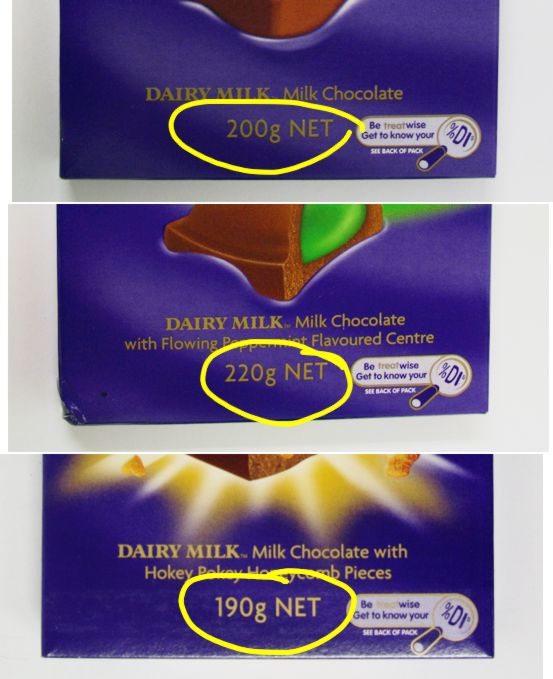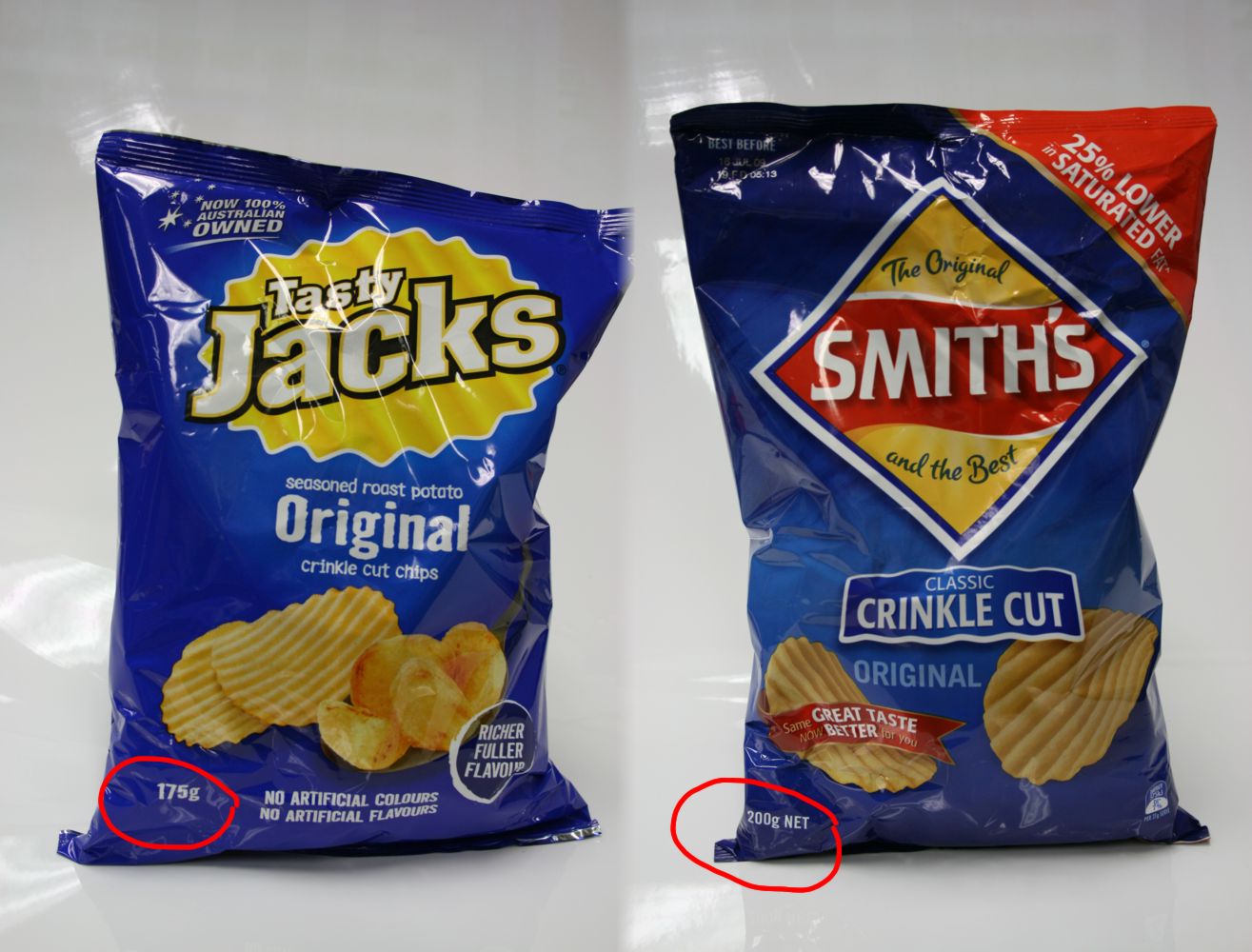Most people probably have a story to tell about products they remember eating as a kid which they return to years later only to claim with some alarm, “I remember these use to be much bigger”. In some instances, certainly, this may be due to an increase in size of the person doing the remembering, however in many cases it is more than likely that the product has in fact actually decreased in size. This marketing ploy is referred to as product shrinkage and is a way of the manufacturers to make a higher rate of return for their product. There are several benefits for the manufacturer in doing this.
Firstly, few people pay particular attention to how big an item is, for instance how many grams is in a tin of heinz big red tomato soup (its is 420g by the way), and so you don’t actually notice small incremental changes in size. Generally you will say, “I am going to buy a block of chocolate”, you probably wouldn’t specify how many grams are in that block of chocolate, ie you wouldn’t say “I am going to buy a 250g block of chocolate or a 200g block or a 100g block”, you just get a block. Now, in general, to make more money, manufacturers can either increase the price of their product or decrease the costs of their product. Manufacturers are generaly fiercely protective of the quality of their product so there is only so much budge room in terms of the costs associated with the ingredients. Customers on the other hand are feircely reactive to price increases, so manufacturers need some other way of increasing the rate of return. They do this by product shrinkage. By making their products slightly smaller but not changing their price they can increase their rate of return on the product.
A second benefit for manufacturers is that the smaller size means that the volume or weight of the product is now less, so when they transport the same volume or weight of product as before, they are actually transporting more units which gives them an increased return for the price paid for transport.
Lastly because the sizes are now different sizes in difficult multiples of other sizes within their own range, or more importantly that of their competitors, customers can not easily determine which product represents the best value.
Now you would expect highly acquisitive brands like Nestle which own everything from brands of moisturiser to Magi two-minute noodles to the chocolate products that it started out with to do things like that, but good old, reliable, family oriented Cadbury I would have expected better from. Product shrinkage for a start shows a profound disrespect for your loyal customers as it is a clear attempt to deceive them.
In the case of the recent resizing of all family sized block varieties of Cadbury chocolate an entire marketing campaign was set up around the resize, in all likelihood to specifically disguise the fact that all the products are now smaller. This involved new block design, which in the case of the fondant varieties (peppermint cream, snack, caramello etc) mean that the cup size is much more shallow, and the squares much more difficult to break. As a result the cups shatter releasing the fondant over your fingers, the packaging or the ground.
The packaging was redesigned and the blocks now come in cardboard boxes, which looks very nice but likely was only done to both go someway towards replacing the weight that was lost with the resized block so people notice it less and also distracting people with the novelty of the new packaging from noticing that the amount of chocolate they are getting is now less.
They also have big point of sale promotion on for the new blocks which are priced from $3.00 to $3.50 at various retailers at the moment. At the same time any retailers that have old stock left have kept the 250g blocks at the old prices, which in recent years has risen to the ludicrous price of about $4.70 for a 250g block. Customers would therefore feel happy about this new look Cadbury then, it costs less, and has a fancy new packaging, without realising that it was only done in order to manipulate them into accepting the new sizing, which they probably haven’t even noticed.
Before the resizing all family blocks of Cadbury chocolate were 250g, except for Breakaway the Cadbury version of the Kit Kat, but now the various flavours have been resized almost randomly to a range of new sizes, eg:

Sure the Cadbury slogan “a glass and a half of full cream dairy milk in every 200g block” has suddenly become more relevant, since the dairy milk block is now back to 200g, as it was originally. But personally I would prefer the larger blocks, and I would prefer less manipulation by one of the worlds best loved chocolate manufacturer. Because of the nature of its products, Cadbury sees us though our most meaningful life experiences, from our first love, to supporting us through our breakups, and our celebrations of success and great achievements, to just saying thank you to those who are important to us. This is what Cadbury means to us, and so for the company to attempt to “market” us into acceptance of its ill-explained resizing is hurtful and I would have expected better from them.
Another product to get the cut recently was Tasty Jack’s chips. They were formerly by Arnott’s but were purchased by an Australian company, Snack Brands Australia so are now both Australian made and Australian owned. I found when I was researching this blog entry though that this purchase was actually completed on the 11th of May 2008 (http://www.foodmag.com.au/Article/Bringing-back-the-snack/172203.aspx). This surprised me as I thought I remembered Arnott’s branded Tasty Jack’s still being available from Coles this year, and certainly late last year. I also remember Arnott’s Tasty Jack’s chips being 200g like Smith’s chips, but now that they are owned by Snack Brands Australia they seem to be 175g.
If companies have to increase prices, and I don’t for a second agree that they do, but if they do, companies should be honest about it, rather than trying to trick us into thinking we are onto a great thing, when really they are just trying to increase their bottom line.


11 responses so far ↓
1 Patricia // May 29, 2009 at 2:18 pm
Cadbury should hang it’s head in shame. I will certainly reconsider any Cadbury purchase from now on. Maybe Nestles should rethink their product and put out a 250 gram chocolate in competition? I would certainly buy it! Thanks for looking out for these resizing rip offs.
2 Richo // Jun 10, 2009 at 9:08 pm
Interesting, I am interested to know what the facts are behind the glass and a 1/2 in each block. Does it really refer to a 200 gram block?
3 Ryan // Aug 14, 2009 at 11:21 pm
I’m not sure that your assumptions about Cadbury’s chocolate are correct here. Sure, we all know that they are downsizing the amount we’re receiving, but in that picture above you show three different flavours of chocolate. Can’t it be expected that there would be weight differences due to the filling inside? For example, honeycomb is definately lighter than milk chocolate and the picture would seem to agree with that fact. Just suggesting that you review your facts first.
4 FastLife // Sep 23, 2009 at 11:37 am
Yes I agree, Ryan. Different component will certainly weigh different amounts for the same volume. I was comparing these new blocks with the previous blocks in which each flavour was the same weight and cost the same price. Now each flavour is a different weight but still cost the same price. It is a way of getting just that little bit more from the customer.
5 Michael Costello // Oct 9, 2009 at 1:41 pm
Damn them to HELL!!!
KFC did the same thing with the Colonel Burger years ago and I’m sure the same applies to the Wagon Wheel.
And while I’m on it this new unit based pricing (in QLD) looked like a great idea until now as the 2 for 1 and 3 for 2 make it difficult to see where the value is. Plus I note not all products have the unit pricing. ARGH!!
The other ‘trick’ is to cram products together on a shelf (like bread) and have the price tags on the shelf all misaligned so where you see 2 for $5 for example if you don’t read very carefully which brand that applies to you can easily grab the wrong brand and pay the full price at the counter.
The big producers have NO respect for the customer.
6 kareena // Oct 4, 2011 at 9:59 pm
Omg’ this is the same thing i being going on about for ages and cadbury on facebook have been saying no no.
7 James // Oct 12, 2011 at 4:08 pm
To give Cadbury’s side they will say it’s not because they are trying to drive more profit but because the increase in global sugar and cocoa prices leave them with a stark choice.
A) Increase the price to cover the higher raw materials costs , or B) Mantain the price by decreasing the size and thus using less raw materials.
Customers notice price rises more than smaller packets so the option chosen is often B, but it’s not quite as black and white as them trying to make huge profits at our expense.
8 FastLife // Oct 12, 2011 at 4:20 pm
I agree James, over time the cost of the raw ingredients do go up. But rather than be honest about it and put the prices up to cover the increased costs, they tend to try to hide it by changing the size of the product in small easily hidden increments, or in the case of this latest cadbury change, in complete repackaging. Why pretend, “We aren’t really putting our prices up” when they clearly are.
Any one who is into chocolate understands that world cocoa production is decreasing, despite increased demand by a larger world population, so obviously prices are going to go up. That is find. Just be up-front about it with your customers, that is all we ask!
9 damian // Jun 30, 2014 at 8:46 pm
I remember this was the time Cadbury became “fair trade” which meant they spotted using children in their factories the down sizing of their products was to compensate for the wages they would’ve paid
10 Saralea // Feb 3, 2015 at 7:00 pm
Yes, and now they’ve done it again….down to just 200gms now. Tsk Tsk Cadbury. Talk about keeping your customers happy.
11 FastLife // Feb 4, 2015 at 10:23 am
The size of the family bock was reduced from 250g to 200g in 2009, it is not clear yet what the new weight will be after the current downsizing, but it will be less than 200g. It is worth keeping in mind though that all companies do it, the chip companies as shown on this page, but biscuit companies and drinks companies. Coke for example brought out all those really pointless, tiny, 200mL cans for $2. They make out that it is this sexy new fun product but bear in mind you are paying $10/L for the coke in those cans, as opposed to $1.60 per L in the 1.25L bottles (current price at Woolies). So effectively they are sneaking in a huge price hike by hiding it in a new product. I actually admire Cadbury for being upfront about what they are doing for this 2015 price rise.